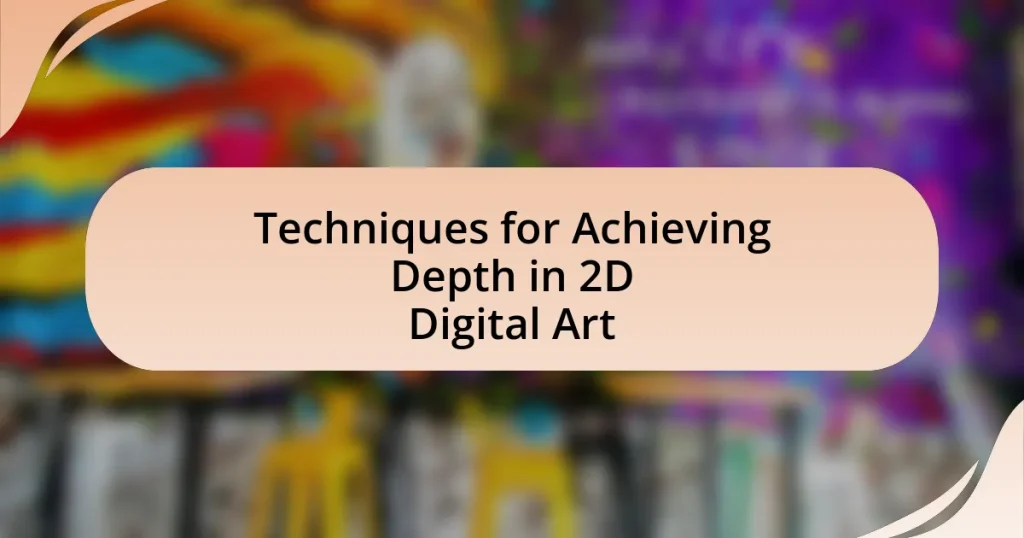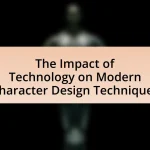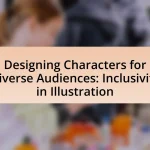The article focuses on techniques for achieving depth in 2D digital art, emphasizing key methods such as layering, atmospheric perspective, and the use of scale. It explores how perspective contributes to depth, detailing types like one-point, two-point, and three-point perspective, along with practical applications of linear perspective. Additionally, the article discusses the role of color, lighting, and texture in creating depth, highlighting advanced techniques and common mistakes to avoid. Resources for further learning are also provided, making it a comprehensive guide for artists seeking to enhance their understanding and application of depth in their digital artwork.
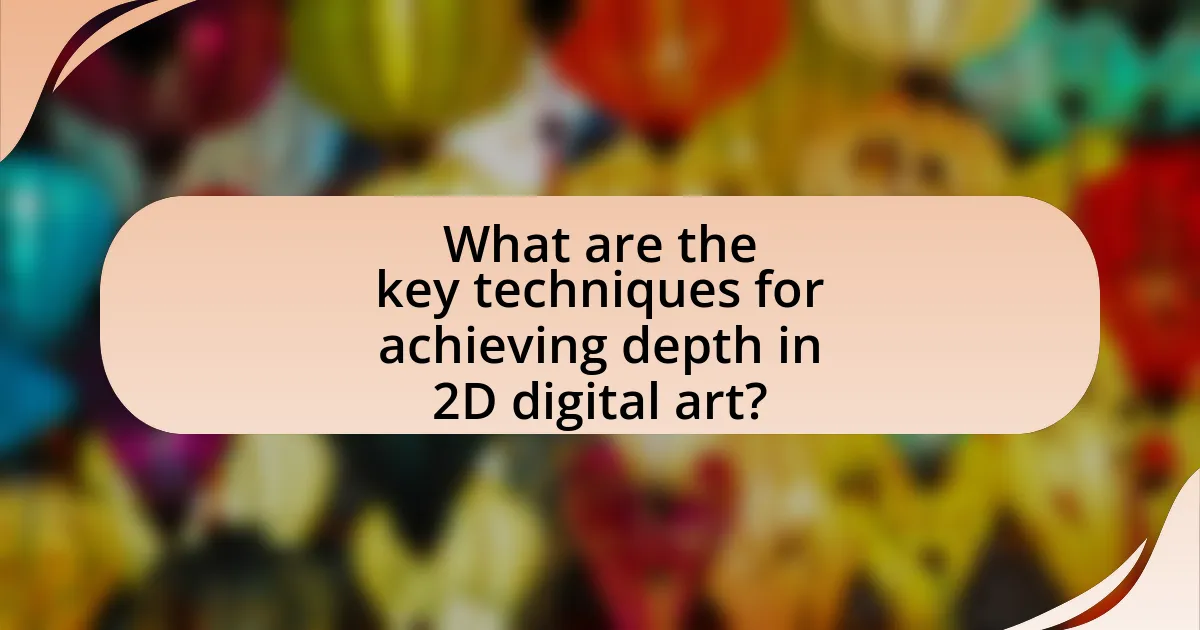
What are the key techniques for achieving depth in 2D digital art?
Key techniques for achieving depth in 2D digital art include layering, atmospheric perspective, and the use of scale. Layering involves placing elements at different distances from the viewer, creating a sense of foreground, middle ground, and background. Atmospheric perspective utilizes color and clarity changes to simulate distance; objects further away appear lighter and less detailed. The use of scale emphasizes the size differences between objects, enhancing the perception of depth. These techniques are widely recognized in art education and practice, demonstrating their effectiveness in creating a three-dimensional feel in a two-dimensional medium.
How does perspective contribute to depth in 2D digital art?
Perspective contributes to depth in 2D digital art by creating the illusion of three-dimensional space on a flat surface. This is achieved through techniques such as linear perspective, where parallel lines converge at a vanishing point, and atmospheric perspective, which uses color and clarity to suggest distance. For example, objects closer to the viewer are depicted with more detail and vibrant colors, while those further away appear lighter and less defined. These methods are grounded in the principles of visual perception, which state that our brains interpret depth cues based on spatial relationships and visual context.
What types of perspective can be used in 2D digital art?
In 2D digital art, the primary types of perspective used are one-point perspective, two-point perspective, and three-point perspective. One-point perspective involves a single vanishing point on the horizon line, creating depth by converging parallel lines towards that point, commonly used in interior scenes. Two-point perspective features two vanishing points on the horizon line, allowing for more dynamic compositions, often seen in architectural drawings. Three-point perspective adds a third vanishing point, typically above or below the horizon line, which is effective for depicting extreme angles or tall structures, enhancing the sense of height or depth. These perspectives are foundational techniques that artists utilize to create a realistic sense of space and dimension in their work.
How does one effectively apply linear perspective in their artwork?
To effectively apply linear perspective in artwork, an artist should establish a horizon line and one or more vanishing points on that line. This technique allows the artist to create the illusion of depth by aligning objects and lines in the composition toward these vanishing points, which mimic how the human eye perceives distance. For instance, in a typical one-point perspective drawing, all parallel lines converge at a single vanishing point, creating a realistic sense of space. Historical examples, such as the works of Leonardo da Vinci, demonstrate the successful use of linear perspective to enhance depth, as seen in “The Last Supper,” where the lines of the architecture lead the viewer’s eye toward Christ at the vanishing point.
What role does color play in creating depth?
Color plays a crucial role in creating depth by influencing perception and spatial relationships in 2D digital art. Warm colors, such as reds and yellows, tend to advance and appear closer to the viewer, while cool colors, like blues and greens, recede and create a sense of distance. This phenomenon is supported by the principles of color theory, which indicate that contrasting colors can enhance the perception of depth. For instance, artists often use a gradient of color saturation and brightness to simulate atmospheric perspective, where distant objects appear lighter and less saturated. This technique is widely recognized in art education and practice, demonstrating that effective color use can significantly enhance the illusion of depth in a two-dimensional space.
How can color gradients enhance the perception of depth?
Color gradients enhance the perception of depth by creating a visual transition that simulates atmospheric perspective. This technique relies on the principle that objects further away appear lighter and less saturated due to the scattering of light in the atmosphere. For instance, in a landscape painting, a gradient that shifts from deep, rich colors in the foreground to lighter, muted tones in the background effectively conveys distance. Research in visual perception supports this, indicating that gradients can influence depth cues, making scenes appear more three-dimensional.
What is the significance of warm and cool colors in depth perception?
Warm and cool colors significantly influence depth perception by creating a sense of spatial relationships in visual compositions. Warm colors, such as reds and yellows, tend to advance in a visual field, making objects appear closer, while cool colors, like blues and greens, recede, giving the illusion of distance. This phenomenon is supported by color theory, which indicates that the human eye perceives warm colors as more prominent and engaging, thus enhancing foreground elements, whereas cool colors provide a calming effect that suggests background elements. Research in visual perception confirms that artists can manipulate these color temperatures to guide viewer attention and create a three-dimensional effect in two-dimensional art.
How does lighting influence depth in 2D digital art?
Lighting significantly influences depth in 2D digital art by creating contrasts that suggest spatial relationships. When artists manipulate light and shadow, they can simulate three-dimensionality on a flat surface, guiding the viewer’s perception of foreground, middle ground, and background. For instance, brighter areas tend to appear closer, while darker regions recede, a principle supported by the concept of atmospheric perspective, where distant objects lose contrast and detail. This technique is widely used in digital art to enhance realism and depth perception, as seen in works by artists like James Gurney, who emphasizes the importance of light in creating depth in his instructional materials.
What are the different lighting techniques that can be used?
Different lighting techniques that can be used in 2D digital art include ambient lighting, directional lighting, and rim lighting. Ambient lighting provides a soft, overall illumination that helps to set the mood without creating harsh shadows. Directional lighting, often mimicking sunlight or a focused light source, creates defined shadows and highlights, enhancing the three-dimensionality of objects. Rim lighting, which highlights the edges of subjects, adds depth and separation from the background, making elements stand out. These techniques are essential for creating a sense of depth and realism in digital artwork.
How can shadows be effectively used to create depth?
Shadows can be effectively used to create depth by establishing contrast and spatial relationships within a composition. When shadows are applied strategically, they enhance the perception of three-dimensionality by indicating the direction of light and the position of objects relative to one another. For instance, a darker shadow beneath an object suggests that it is resting on a surface, while softer shadows can imply distance and atmospheric perspective. Research in visual perception indicates that our brains interpret shadows as cues for depth, as demonstrated in studies by researchers like Richard Gregory, who highlighted the role of shadows in depth perception. Thus, incorporating well-defined shadows can significantly enhance the viewer’s understanding of spatial arrangement in 2D digital art.
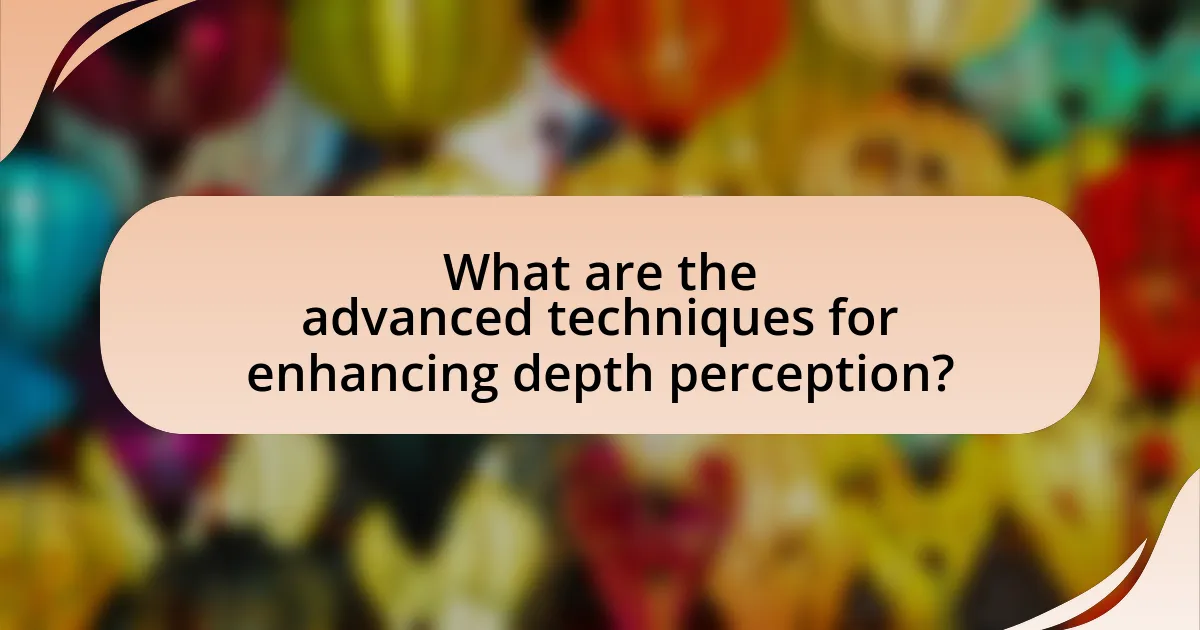
What are the advanced techniques for enhancing depth perception?
Advanced techniques for enhancing depth perception in 2D digital art include the use of atmospheric perspective, layering, and contrast manipulation. Atmospheric perspective involves creating a gradient of color and clarity to simulate distance, where objects further away appear lighter and less detailed. Layering techniques involve placing elements at varying depths within the composition, utilizing foreground, midground, and background to create a sense of spatial hierarchy. Contrast manipulation enhances depth by adjusting the brightness and saturation of elements; objects in the foreground are typically more vibrant and detailed, while those in the background are muted. These techniques are supported by principles of visual perception, which indicate that our brains interpret depth cues based on color, clarity, and spatial arrangement.
How can texture be utilized to create a sense of depth?
Texture can be utilized to create a sense of depth by varying its application across different elements in a composition. In 2D digital art, foreground elements often feature more detailed and pronounced textures, while background elements display softer, less defined textures. This contrast enhances the perception of spatial relationships, as detailed textures draw the viewer’s eye forward, creating an illusion of proximity. For instance, artists frequently employ techniques such as layering textures and adjusting their opacity to simulate atmospheric perspective, where distant objects appear less textured and more muted due to the effects of air and distance. This method is supported by principles of visual perception, which indicate that texture influences how we interpret spatial depth, as evidenced by studies in art theory and psychology.
What types of textures are most effective for depth in 2D art?
Effective textures for creating depth in 2D art include rough, layered, and gradient textures. Rough textures, such as those resembling natural surfaces like stone or bark, create a tactile quality that enhances the perception of depth. Layered textures, which involve overlapping elements, can simulate atmospheric perspective by suggesting distance and dimensionality. Gradient textures, transitioning smoothly from one color to another, can evoke depth through shading and light variation, reinforcing the illusion of three-dimensionality. These texture types are widely recognized in art theory and practice for their ability to manipulate visual perception and enhance spatial relationships in a two-dimensional medium.
How can layering textures contribute to a three-dimensional feel?
Layering textures enhances a three-dimensional feel by creating visual complexity and depth in two-dimensional digital art. When multiple textures are applied in varying opacities and orientations, they simulate the interplay of light and shadow, which is essential for perceiving depth. For instance, a rough texture layered over a smooth background can suggest proximity and dimensionality, as the viewer’s eye interprets the contrast in surface qualities. This technique is supported by principles of visual perception, where overlapping elements and varied textures lead to a more immersive experience, effectively tricking the brain into perceiving depth in a flat medium.
What is the importance of scale and proportion in depth perception?
Scale and proportion are crucial in depth perception as they help viewers interpret spatial relationships and distances in a two-dimensional space. When objects are represented with accurate scale and proportion, it allows the brain to gauge their relative size and position, creating a convincing sense of depth. For instance, larger objects are perceived as being closer, while smaller objects appear further away, which aligns with the principles of visual perception established in studies like those by Richard Gregory, who emphasized the role of size constancy in depth perception. This understanding is essential in 2D digital art, where artists manipulate scale and proportion to enhance the illusion of three-dimensionality, guiding the viewer’s eye and creating a more immersive experience.
How can varying sizes of objects create a sense of distance?
Varying sizes of objects can create a sense of distance by utilizing the principle of scale, where larger objects appear closer and smaller objects seem farther away. This visual cue is rooted in human perception, as our brains interpret size differences as indicators of spatial relationships. For example, in a landscape painting, a large tree in the foreground can dominate the scene, while smaller trees in the background suggest depth and distance. This technique is supported by the concept of perspective in art, where objects diminish in size as they recede into the background, reinforcing the illusion of three-dimensional space on a two-dimensional surface.
What techniques can artists use to maintain proportion while adding depth?
Artists can maintain proportion while adding depth by employing techniques such as linear perspective, atmospheric perspective, and the use of scale. Linear perspective involves creating a grid of converging lines that guide the placement of objects, ensuring they appear proportionate relative to one another as they recede into the background. Atmospheric perspective relies on color and clarity to depict depth; objects further away are rendered with lighter colors and less detail, which helps maintain their proportional relationship to foreground elements. Additionally, using scale effectively allows artists to compare sizes of objects in relation to one another, reinforcing the illusion of depth while keeping proportions accurate. These techniques are foundational in art, as seen in works by masters like Leonardo da Vinci, who utilized these methods to create realistic spatial relationships in his paintings.
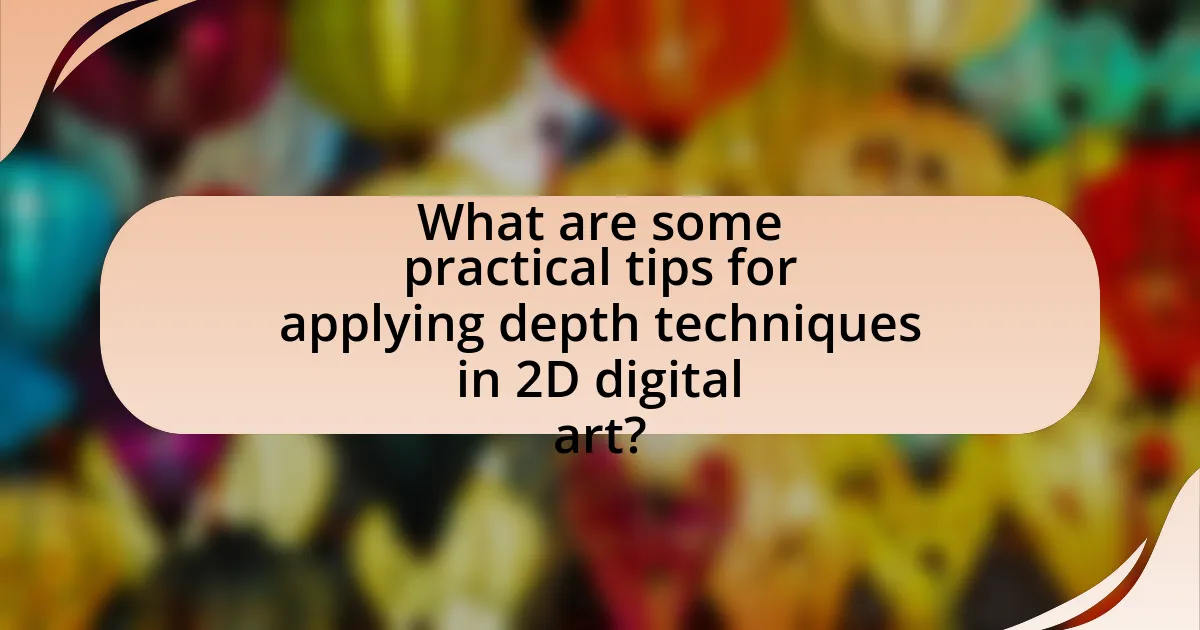
What are some practical tips for applying depth techniques in 2D digital art?
To apply depth techniques in 2D digital art, utilize layering, atmospheric perspective, and scale variation. Layering involves placing elements at different distances from the viewer, creating a sense of foreground, middle ground, and background. Atmospheric perspective can be achieved by using lighter and less saturated colors for distant objects, which mimics how the atmosphere affects visibility. Scale variation refers to adjusting the size of objects; larger objects appear closer while smaller ones seem further away. These techniques are supported by principles of visual perception, which indicate that our brains interpret depth through spatial relationships and color changes.
How can artists practice depth techniques effectively?
Artists can practice depth techniques effectively by employing methods such as atmospheric perspective, layering, and scale variation. Atmospheric perspective involves using color and clarity to create the illusion of depth; for instance, distant objects appear lighter and less detailed. Layering involves placing elements at different distances from the viewer, which can be enhanced by adjusting opacity and blurring for background elements. Scale variation refers to changing the size of objects to indicate their distance from the viewer, where larger objects appear closer. These techniques are supported by principles of visual perception, which demonstrate how the human eye interprets depth cues in art.
What exercises can help improve depth perception in digital art?
Exercises that can help improve depth perception in digital art include creating layered compositions, practicing atmospheric perspective, and utilizing value and color contrast. Layered compositions involve arranging elements at varying distances to simulate depth, while atmospheric perspective requires artists to depict distant objects with less detail and lighter colors, mimicking how the atmosphere affects visibility. Additionally, using value and color contrast effectively can enhance the perception of depth by making foreground elements more vibrant and detailed compared to the background. These techniques are supported by principles of visual perception, which indicate that our brains interpret depth through cues such as overlap, size variation, and color saturation.
How can feedback from peers enhance depth techniques in artwork?
Feedback from peers can enhance depth techniques in artwork by providing diverse perspectives that identify areas for improvement and innovation. When artists receive critiques from fellow creators, they gain insights into how effectively depth is conveyed through techniques such as layering, shading, and perspective. For example, peer feedback can highlight whether the use of color gradients effectively creates a sense of distance or if the composition successfully guides the viewer’s eye through the artwork. Studies in art education have shown that collaborative critique sessions lead to improved artistic skills and deeper understanding of visual elements, as artists learn to articulate their choices and consider alternative approaches. This exchange fosters a more nuanced application of depth techniques, ultimately enriching the artwork.
What common mistakes should artists avoid when creating depth?
Artists should avoid using flat colors and neglecting contrast when creating depth. Flat colors can make a composition appear two-dimensional, while a lack of contrast diminishes the perception of spatial relationships. Additionally, artists often mistakenly ignore atmospheric perspective, which involves using lighter and less saturated colors for distant objects to enhance depth. Failing to vary the size and scale of objects can also lead to a lack of depth, as larger objects appear closer and smaller objects appear further away. Lastly, artists should not overlook the importance of overlapping elements, as this technique creates a sense of layering and spatial organization.
How can understanding these mistakes improve overall artwork quality?
Understanding mistakes in artwork enhances overall quality by allowing artists to identify and rectify common pitfalls, leading to more effective techniques. For instance, recognizing errors in perspective can significantly improve the illusion of depth, as accurate perspective is crucial for creating a three-dimensional feel in two-dimensional art. Studies show that artists who analyze their mistakes develop a deeper understanding of composition and spatial relationships, which directly contributes to the visual impact of their work. By learning from these errors, artists can refine their skills, resulting in artwork that is not only technically proficient but also more engaging and visually appealing.
What resources are available for learning more about depth in 2D digital art?
Resources for learning about depth in 2D digital art include online courses, tutorials, and books specifically focused on this aspect. Websites like Skillshare and Udemy offer courses that cover techniques such as atmospheric perspective and layering, which are essential for creating depth. Additionally, YouTube channels like Ctrl+Paint and Proko provide free tutorials that demonstrate practical methods for achieving depth. Books such as “Color and Light: A Guide for the Realist Painter” by James Gurney also offer valuable insights into depth perception in art. These resources are widely recognized in the art community for their effectiveness in teaching depth techniques.
